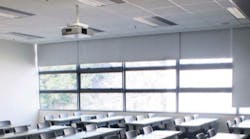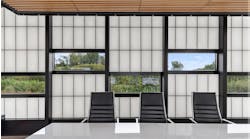If you've picked up a newspaper or business publication lately, chances are you've read about "Gen Y" or the "Millennial Generation," the population of young adults born between the 1980s and late 1990s. Gen Y has affected everything from technology to workplace management, but when it comes to the education construction industry, does the Millennial Generation really play a role? Definitely.
According to a recent study, "Generation Y will be the generation to carry the load of years of environmental damages and neglect. It is embracing sustainability, and Generation Z, the generation that will follow Generation Y, is even more modeled around the concept of sustainability. The results reflect this new way of living."
For education institutions, this data means that prospective students aren't simply looking at traditional factors — cost, reputation, academics and financial aid — when selecting a school. Students are more concerned than ever about their impact on the environment, and they demand that academic institutions share their commitment to sustainability, oftentimes beyond the minimum level of environmental compliance standards.
Need more proof? Consider sites like www.greenreportcard.org, a website created to provide in-depth sustainability profiles of schools across the country.
Meeting Expectations
Growing up in a more eco-conscious world, incoming students are more savvy about "greening" the world around them. A decade ago, green college campuses were those that offered recycling bins in residence halls. Now education institutions are integrating sustainability efforts into as many aspects of their campus operations as possible. And that includes construction: When constructing or remodeling buildings on campus, education institutions' requests to construction companies have been moving decidedly in the green direction.
The construction industry has been ahead of the curve for a while in terms of adhering to LEED standards and helping institutions become more energy-efficient and environmentally friendly. In recent years, that has meant much more than using renewable construction materials or installing solar panels. The demand for more eco-friendly lighting options in particular has increased, and the industry has been quick to adapt, which in turn serves as a selling point to students who are focused on sustainability.
So, whether an institution is considering new construction or renovating an existing space, there are ways to integrate sustainability into lighting schemes. A few eco-friendly lighting options that appeal to students include:
-
Installing larger windows in common areas to let in more natural light, thereby eliminating or reducing the use of electric lighting during daylight hours. Daylighting has been around for years in commercial office buildings, but is becoming more common in education institutions. Primarily incorporated into new construction, daylighting is both a practical and aesthetic design decision.
-
As a result of more natural light coming into common areas, solar lighting increasingly is being installed in conjunction with daylighting. Smaller solar panels installed inside a building collect light and convert it into energy to keep classrooms lighted during evening hours.
-
Energy-efficient bulbs are being installed in more classrooms to reduce utility bills as well as display an institution's pledge to sustainability.
Lighting Up the Bottom Line
Attracting students and staying on top of eco-friendly trends is important, but cost and practicality also play a large role in institutions using lighting to their advantage. Utility bills are one of the costliest expenses that education institutions face, and schools are finding ways to use creative and sustainable lighting options to their full advantage.
In the past, education institutions typically have chosen standard lighting designs in their buildings, using a mix of fluorescents and incandescent lighting. However, they are finding that lighting has an important role not only in controlling energy costs, but also in framing the atmosphere.
The facts are in the black … ink, that is. Lighting can save money, help the environment, and set the mood for both common areas and classroom settings.
Setting the Mood
Effective lighting does more than simply add to an institution's "green" factor or improve its bottom line. Lighting can influence everything from atmosphere to learning environment. Schools and universities are becoming savvier about how lighting contributes to an academic setting.
In response, construction companies are accommodating an influx of requests for diverse lighting schemes, including fixtures with specific lighting color temperatures.
There are many benefits of using different lighting color temperatures in certain areas of buildings. For example, warmer light (lower color temperatures) can make a room appear more welcoming; in turn, cooler tones can aid in concentration. As a result, construction companies have begun expanding their lighting options to better accommodate these requests.
The Future of Lighting
More lighting options for education institutions will become available as demand increases. For instance, LED lighting is extremely energy-efficient and long-lasting; however, the fixtures are expensive right now. As the fixture price falls during the next few years, it will become a more popular option for institutions to consider.
LED lighting commonly is used in locations that require some illumination, with no concern to the tone of the light. For example, parking garages and storage locations are the likeliest candidates for this type of lighting. This is especially useful in areas that have no way of capturing solar energy.
Thurnquist is a preconstruction manager and Danis is the director of business development at Danis Building Construction, Miamisburg, Ohio. Thurnquist can be reached at [email protected]. Danis can be reached at [email protected].


